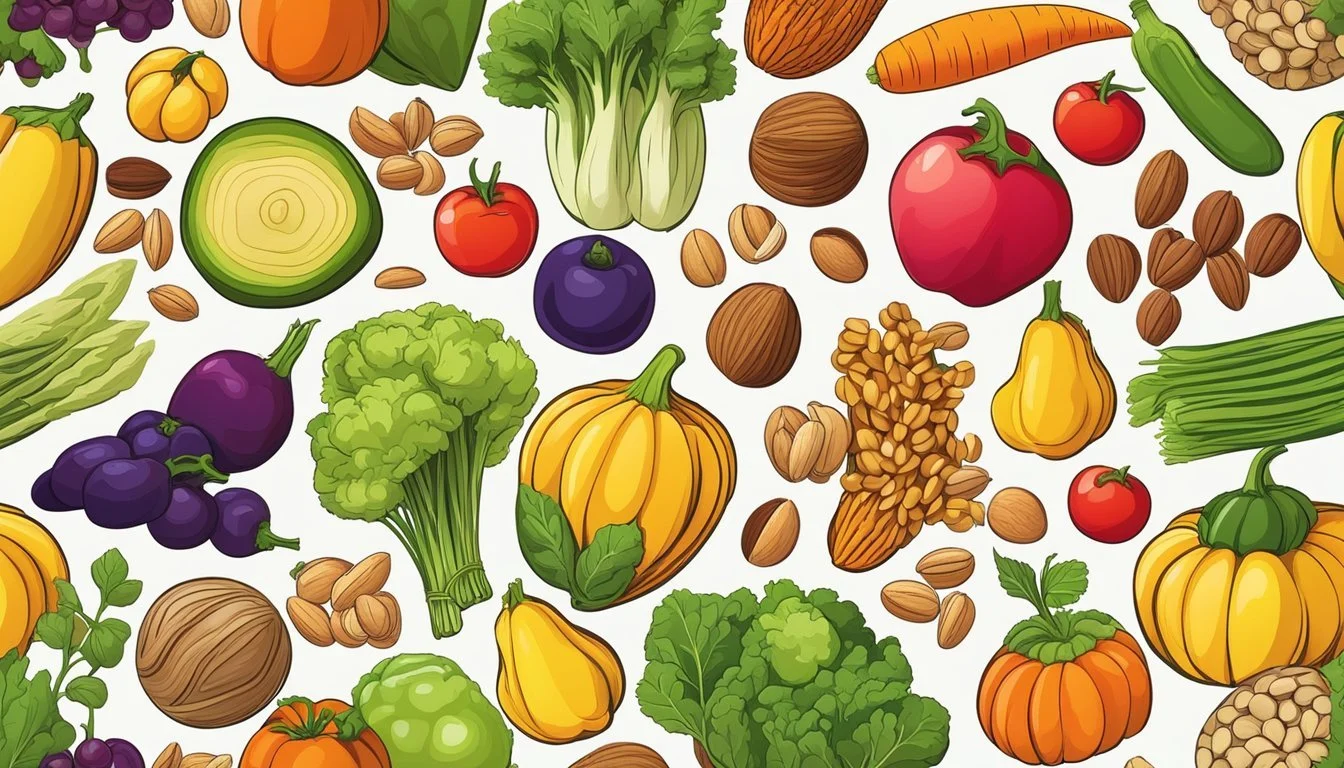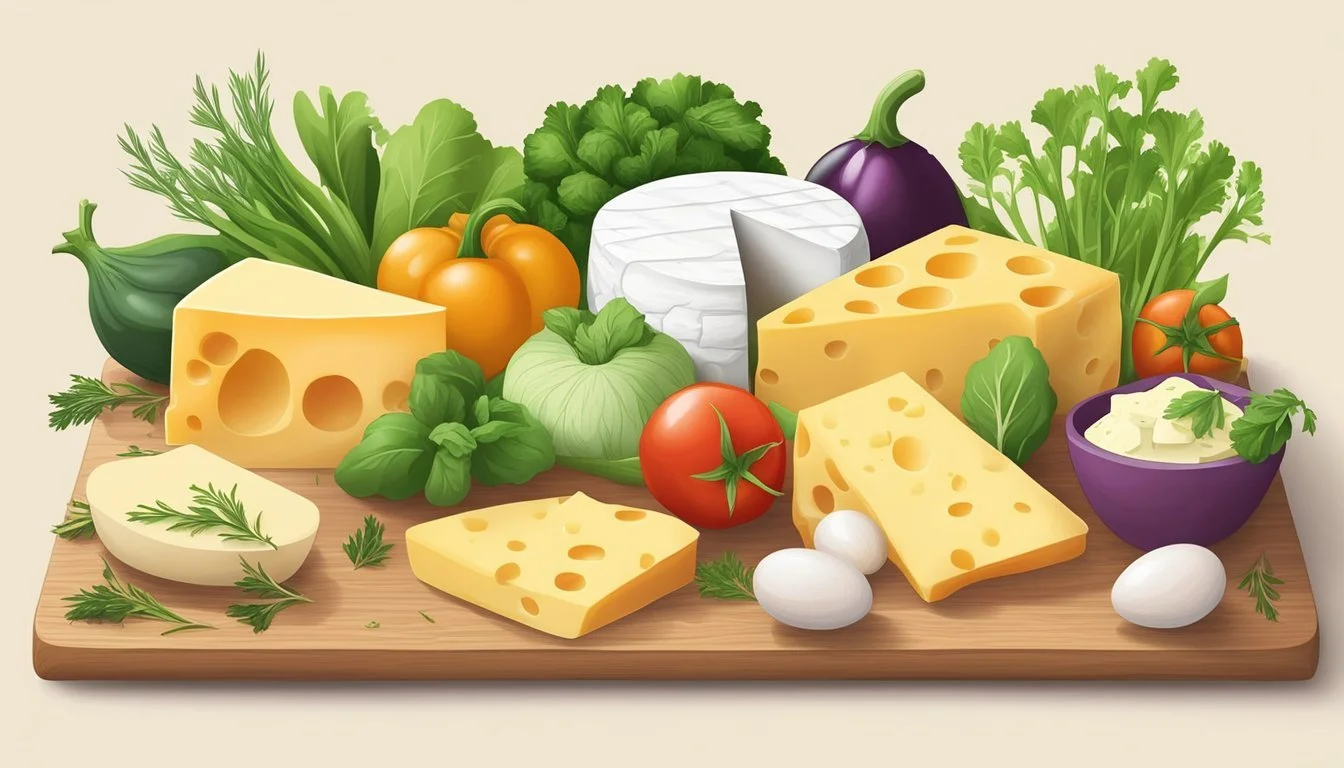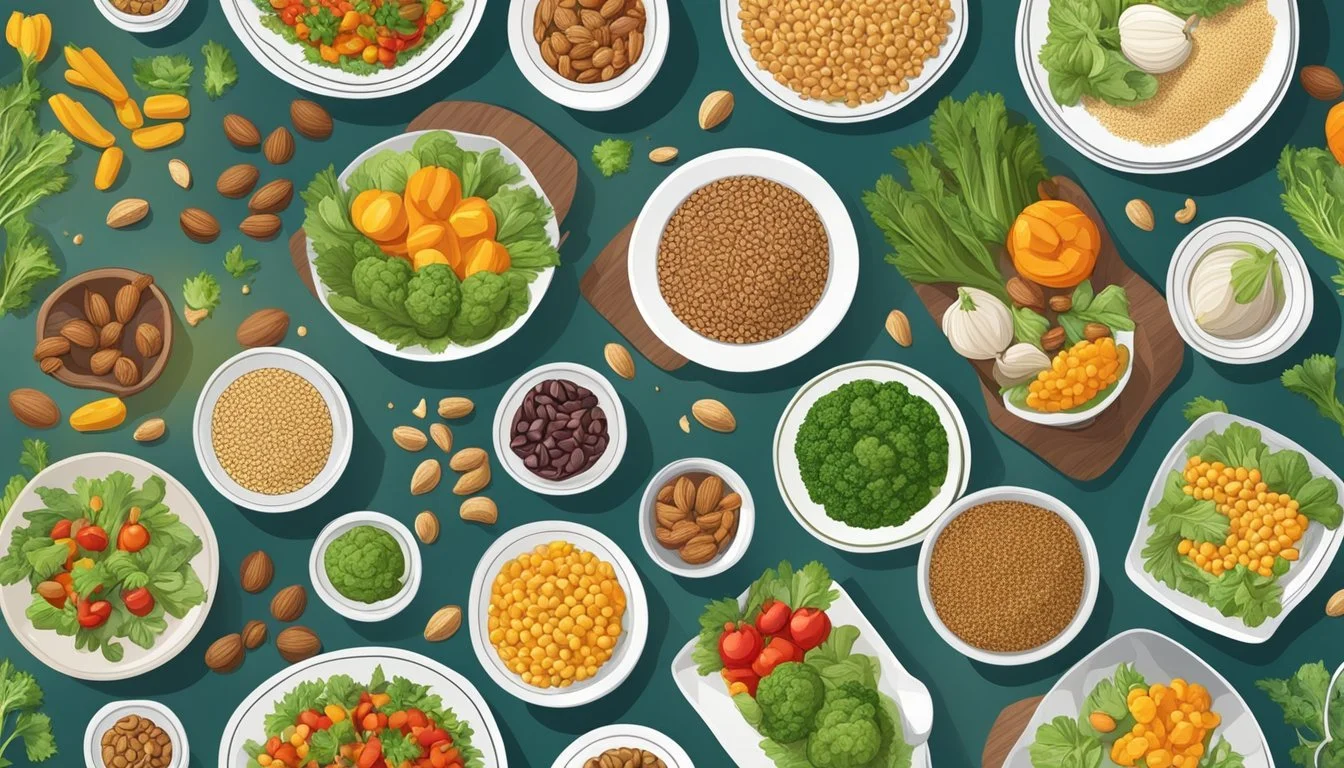Best Foods for a Healthy and Filling Vegetarian Diet
Your Ultimate Guide
Adopting a vegetarian lifestyle can be a fulfilling and health-promoting choice, with ample delicious and nutritious options available. As vegetarianism gains popularity for its environmental, health, and ethical benefits, finding satisfying meals that provide all the necessary nutrients is a key focus. Plant-based proteins are an essential component of any vegetarian diet, as they serve as the building blocks for a healthy body, aiding in muscle repair, hormone production, and overall energy levels.
Vegetarian recipes and meals offer a diverse range of flavors and nutrients, with many dishes including beans, lentils, tofu, and chickpeas as protein-rich ingredients. These plant-based proteins are not only beneficial for health but are also versatile, allowing them to be the stars in a variety of culinary creations. From sumptuous soups and chilis to robust salads and hearty entrees, the options for fulfilling vegetarian eating are seemingly endless.
Vegetables, grains, and legumes form the foundation of the vegetarian diet, providing an array of vitamins, minerals, and fibers essential for optimal health. Meals such as stuffed eggplant with melted mozzarella, black bean veggie burgers, and tacos with spiced roasted cauliflower showcase how a balanced vegetarian meal can be both satiating and flavorful. Incorporating these foods into one's diet ensures adequate nutrient intake without compromising on taste, making the journey of eating vegetarian both a healthy and enjoyable experience.
The Importance of Proteins in a Vegetarian Diet
Proteins are crucial for bodily functions, serving as building blocks for muscles, tissues, and enzymes. For vegetarians, obtaining adequate protein solely from plant sources requires mindful dietary choices.
Incorporating Plant-Based Proteins
Plant-based proteins can effectively support a vegetarian diet. Tofu, derived from soy, offers a versatile protein source rich in iron and calcium, with approximately 12-20 grams of protein per 3.5 ounces. Tempeh, also made from soy, is a fermented option that contains a similar protein content and offers additional gut health benefits. Edamame, young soybeans, provides both protein and essential amino acids critical for health.
A detailed look at some common plant-based proteins is as follows:
Tofu: 12-20g per 3.5 oz
Tempeh: 12-20g per 3.5 oz
Edamame: Varies, typically around 17g per cup.
These sources are not only high in protein but also contain other vital nutrients such as calcium and iron.
Using Legumes for Protein
Legumes, including lentils, beans, and chickpeas, are central to a vegetarian's protein supply. They deliver fiber, protein, and complex carbohydrates, making them a filling component of any meal. Lentils boast about 18 grams of protein per cooked cup, while beans and chickpeas have about 15 grams per cup. Incorporating a variety of legumes into one's diet ensures an array of nutritional benefits.
Here’s a snapshot of the protein content in popular legumes:
Lentils: ~18g per cup (cooked)
Beans: ~15g per cup (cooked), varies by type
Chickpeas: ~15g per cup (cooked)
In both subsections, nuts, while not as high in protein as soy products and legumes, are an excellent supplemental protein source, with protein contents varying across types. Almonds and peanuts, for example, provide approximately 6-7 grams of protein per ounce, and nut butters offer a convenient, protein-rich spread.
Crafting Satisfying Vegetarian Meals
Creating satisfying vegetarian meals requires a focus on incorporating whole grains, a variety of vegetables, and protein-rich meatless options. These elements ensure that each meal is not only nutritious but also appealing to both vegetarians and meat eaters looking for a fulfilling meatless meal.
The Role of Whole Grains
Whole grains are a staple in vegetarian meals for their ability to provide sustained energy and satiety. Using grains like brown rice, quinoa, and barley can add both texture and nutritional value to a dish. For example:
Brown rice: Offers fiber and pairs well with stir-fried vegetables or as a base for vegetarian casseroles.
Quiona: A complete protein, suitable for salads or stuffed peppers.
Barley: Chewy and satisfying, perfect for hearty soups and stews.
These grains serve as a versatile foundation for a range of vegetarian dishes (What wine goes well with vegetarian dishes?), from simple bowls to elaborate bakes.
Including Varied Vegetables
To keep vegetarian meals interesting, incorporating a variety of vegetables is key. They offer a spectrum of flavors, textures, and nutrients.
Leafy greens: Spinach (What wine goes well with spinach?), kale, and arugula contribute iron and calcium.
Cruciferous vegetables: Broccoli and cauliflower provide fiber and can be roasted for a nutty flavor.
Root vegetables: Sweet potatoes (What wine goes well with sweet potatoes?) and carrots add natural sweetness and body to dishes.
Using a colorful array of vegetables ensures each vegetarian dish is as appealing to the eye as it is to the palate.
Innovative Meatless Dishes
Transitioning from traditional meat-based dishes to meatless alternatives does not mean sacrificing taste or satisfaction. Creating innovative vegetarian dishes often involves:
Protein-rich ingredients: Beans, lentils, chickpeas, tofu, and tempeh can replace meat and ensure the meal is filling.
Herbs and spices: They can transform simple ingredients into complex, rich flavors.
Cheese and nuts: Offer additional textures and flavors to salads, pastas, and casseroles.
Through thoughtful preparation and strategy, chefs can make meatless meals that stand up to their meat-containing counterparts in both flavor and fullness.
Vegetarian Recipes for Different Meal Times
Creating a well-rounded vegetarian menu throughout the day can be an enjoyable and nutritious endeavor. Here's a guide to delicious vegetarian recipes tailored for different meal times, ensuring both health and satisfaction with every bite.
Breakfast Favorites
A balanced breakfast can jumpstart the day with energy and nutrients. Frittatas offer a customizable option where one can load up on seasonal veggies and cheese for a protein-rich start. Another quick and appealing choice is a Stuffed Sweet Potato with Hummus Dressing, combining complex carbohydrates with heart-healthy fats for lasting fullness.
Lunch Ideas
Midday meals should be refreshing yet satiating. Veggie burgers are a versatile option, easily made with black beans or lentils and served with a variety of toppings for a hearty lunch. For those seeking comfort with a twist, Okonomiyaki, a savory Japanese pancake loaded with cabbage and other vegetables, provides a satisfying and unique lunch experience.
Hearty Vegetarian Dinners
Dinner is the perfect time for hearty dishes that satisfy. Vegetarian Chili (What wine goes well with vegetarian chili?) brims with beans and vegetables, delivering a fulfilling entree that's both nutrient-dense and warming. On the other hand, Baked Ziti, with its layers of pasta, ricotta, and marinara sauce, topped with melted cheese, stands as a family favorite, offering a crowd-pleasing dinner option that doesn't skimp on flavor.
Side Dishes and Small Plates
Complementing main courses with side dishes can add variety and completeness to any meal. A Side of Roasted Cauliflower or a plate of Warm Orzo with Pine Nuts and Chickpeas can enhance a vegetarian meal by adding different textures and flavors, along with a host of beneficial nutrients. Small plates like these are not only delicious but also contribute to a balanced diet.
Quick and Easy Vegetarian Options
For those seeking nourishment without the toil, vegetarian cuisine offers quick and easy options suitable for a tight schedule or lazy evening. These meat-free choices are not only simple to prepare but also packed with flavor and nutrition.
Pantry Staples for Last-Minute Meals
A well-stocked pantry is the cornerstone of rapid, effortless vegetarian cooking. Essential Pantry Staples include:
Canned beans: A versatile protein source, ready to eat. Black beans are ideal for whipping up quick taco fillings or hearty soups.
Whole grains: Quinoa, brown rice, and couscous (What wine goes well with couscous?) serve as the base for nourishing grain bowls.
Pasta: Integral for fast meals, choose whole wheat for a fiber boost.
Canned tomatoes: The foundation for numerous vegetarian dishes, such as meatless soups and sauces.
Fast and Flavorful Weeknight Dinners
On busy weeknights, the objective is to minimize time without sacrificing taste. Select meals that marry convenience with zest:
Meatless Soups: A can of tomato soup, enhanced with white beans and greens, transforms into a satisfying meal in under 10 minutes.
Grain Bowl: Assemble a grain bowl using precooked grains, topped with a colorful medley of sautéed or raw vegetables, and a protein source like canned chickpeas, all drizzled with a quick vinaigrette or tahini sauce.
Black Bean Tacos: Fill corn tortillas with canned black beans, avocado slices, fresh salsa, and shredded cheese for a meal that’s ready in a flash.
Curried Butternut Squash Soup: Combine roasted butternut squash with curry powder, vegetable broth, and coconut milk for a warming dish that’s simple to prepare.
Cheese and Eggs: A Versatile Component
In a vegetarian diet, cheese and eggs serve as powerful sources of protein and can be used in a multitude of dishes, providing both flavor and nutritional value.
Egg-Based Vegetarian Classics
Eggs are a cornerstone in vegetarian cuisine due to their versatility and rich protein content. They feature prominently in breakfast dishes like veggie scrambles and omelets, where spinach, mushrooms, and goat cheese are common add-ins for enhanced taste and nutrition. Incorporating eggs into breakfast can help maintain satiety throughout the morning. Eggplant parmesan (What wine goes well with eggplant parmesan?) is another classic dish that relies on the binding and enriching qualities of eggs, layering them with slices of eggplant, marinara sauce, and mozzarella or parmesan cheese for a comforting meal.
Cheese in Vegetarian Cooking
Cheese adds a depth of flavor and richness to vegetarian dishes. It plays a central role in recipes such as fettuccine alfredo where parmesan cheese melds with cream to create a luxurious sauce. Varieties like feta cheese, with its tangy profile, enhances salads and Mediterranean-inspired dishes, while mozzarella is a staple in Italian cooking, melting beautifully on pizzas and within sandwiches. Making a vegetarian grilled cheese sandwich is elevated by experimenting with different types of cheese, such as sharp cheddar or creamy gouda, often paired with whole-grain bread and an array of vegetables for a nutritious twist on a classic.
Balancing Nutrition and Taste
In crafting vegetarian dishes that satisfy both nutritional needs and taste preferences, chefs focus on integrating a diversity of ingredients that lend themselves to healthful yet flavorful outcomes. Incorporating a variety of vegetables alongside beans, whole grains, and key vitamins ensures meals are both satisfying and nutritious.
Healthful Vegetable-Forward Dishes
Vegetable-forward dishes are at the heart of a balanced vegetarian diet, combining nutrient density with rich flavors. Sweet potatoes and roasted root vegetables provide essential vitamins and minerals, while also contributing natural sweetness and a satisfying texture to meals. For example, a dish that incorporates roasted sweet potatoes with a medley of spinach and other leafy greens can offer a substantial source of iron and vitamin A.
Key components of a healthful vegetable-forward dish include:
A variety of colorful vegetables for a wide range of nutrients.
A source of protein, such as beans or tofu, to round out the meal.
Comfort Food with a Vegetarian Twist
Vegetarian comfort food often transforms traditional meat-based recipes into meatless wonders that retain the same heartiness and richness. Spinach, an incredibly versatile leafy green, works well in creamy casseroles and savory pies, providing a nutritious boost. Making a vegetarian sweet potato cauliflower curry can serve as a lower-calorie, but equally indulgent, alternative to the classic chicken curry, offering depth of flavor and high dietary fiber content.
Examples of vegetarian twist on comfort food:
Spinach and cheese lasagna – replacing meat with layers of spinach, ricotta, and marinara sauce.
Sweet potato shepherd's pie – using mashed sweet potatoes as a nutrient-rich topping over a savory lentil and vegetable filling.
Adapting Traditional Meat Dishes for Vegetarians
Transitioning to a vegetarian diet doesn't mean abandoning the flavors and textures meat eaters enjoy. Instead, it involves adapting classic meat dishes to vegetarian versions using meatless alternatives and hearty vegetables.
Vegetable-Centric Variations
In vegetarian cuisine, mushrooms standout as a robust substitute for meat, offering a meaty texture and savory flavor profile. Dishes like lentil Bolognese can incorporate mushrooms and lentils to create a deeply satisfying sauce that mimics the traditional meat-based version. Similarly, eggplant Parmesan provides a filling and nutritious option, where thick slices of eggplant replace the chicken or veal typically used in Parmesan-style dishes.
Moussaka can be made with layers of portobello mushrooms or even seitan (What wine goes well with seitan?) instead of meat to maintain its richness.
Vegetarian Paella: Utilizing an array of vegetables and sometimes tofu, this recipe retains the essence of the Spanish classic without the meat and shellfish.
Vegan Alternatives to Meat-Based Classics
When it comes to vegan adaptations, the use of plant-based proteins like tempeh effectively replaces meat in various recipes. Tempeh has a hearty, nutty flavor and is nutrient-dense, making it ideal for recreating dishes like meatloaf or tacos. Black bean tacos offer a fiber-rich and protein-packed twist to traditional tacos, easily satisfying even the most discerning palates.
Veggie Burgers: Crafted from beans, grains, and an assortment of vegetables, veggie burgers provide a satisfying and flavorful alternative to their meat counterparts.
Meatless Meals: Dairy-free versions of classic meals can be concocted using cheese and cream alternatives, effectively capturing traditional comfort foods' essence without animal products.
Exploring International Vegetarian Cuisines
Venturing into international vegetarian cuisines reveals a tapestry of flavors and ingredients, catering to both the health-conscious and those seeking culinary adventure. These dishes not only satisfy but also introduce a variety of nutrients into a vegetarian diet.
Asian-Inspired Vegetarian Delights
Japchae from South Korea is a prime example of a robust vegetarian dish that combines sweet potato noodles with a colorful array of vegetables, including spinach and carrots. These are stir-fried with onion and garlic, all melded together with a sweet soy and sesame sauce.
Another notable dish from Asia is Okonomiyaki, a Japanese savory pancake. This versatile vegetarian delight typically consists of:
Cabbage
Flour
Eggs It allows for a range of additional vegetable toppings and can be garnished with a variety of condiments, including a hummus dressing for a fusion twist.
Mediterranean Vegetarian Favorites
The Mediterranean diet excels in offering a plethora of vegetarian options. One staple of this cuisine is a simple yet incredibly satisfying pasta dish. It can be served with a rich marinara sauce, which is both hearty and healthy.
Furthermore, Refried beans represent a staple in the vegetarian diet across the Mediterranean and can serve as a protein-rich side or as a filling for vegetarian wraps and burritos.
For a dip or spread, look no further than hummus. Its primary ingredient, chickpeas, is blended with tahini, garlic, and lemon juice, and it's often served with a drizzle of olive oil. This dish is not only a vegetarian favorite but is also packed with nutrients and can be adapted with additional flavors, such as roasted red peppers or caramelized onions.
Accessorizing Vegetarian Dishes
A well-accessorized dish can transform simple vegetarian fare into an elegant and nutritious meal. Carefully chosen sides and condiments, along with creative dressings and toppings, can elevate the flavors and textures while providing a balanced diet.
Sides and Condiments
The right side dishes can complement and enhance the main course. Grains such as quinoa, brown rice, and barley offer not only a boost of fiber but also a chewy or fluffy texture that pairs well with vegetables. A side dish of grains can act as a canvas for a variety of flavors.
Quinoa: Provide a protein-packed base for roasted vegetables
Brown Rice: Ideal for soaking up rich, flavorful sauces like tomato sauce
Barley: Adds heartiness to soups and stews
Condiments also play a crucial role. A dollop of hummus on a plate not just adds a creamy texture but also protein and healthy fats.
Tomato Sauce: Works as a vibrant, acidic addition to eggs or tofu scrambles.
Hummus: Serves as a rich, savory spread for wraps or a dip for crudités.
Dressings and Toppings
A drizzle of dressing or a sprinkle of toppings can turn a basic dish into a gourmet experience. Hummus dressing, with its rich flavor profile, can effortlessly dress salads or grain bowls.
Hummus Dressing: Can be thinned with a bit of water or lemon juice for a lighter consistency.
Toppings like toasted nuts, seeds, or avocado slices add not just flavor but also textures that make the dish more satisfying.
Toasted Pine Nuts: Offer a nutty crunch to salads or pasta dishes.
Avocado Slices: Provide a buttery, rich complement to crisp, fresh greens.
Incorporating an array of sides, condiments, dressings, and toppings is key to achieving a balanced and exciting vegetarian meal.







